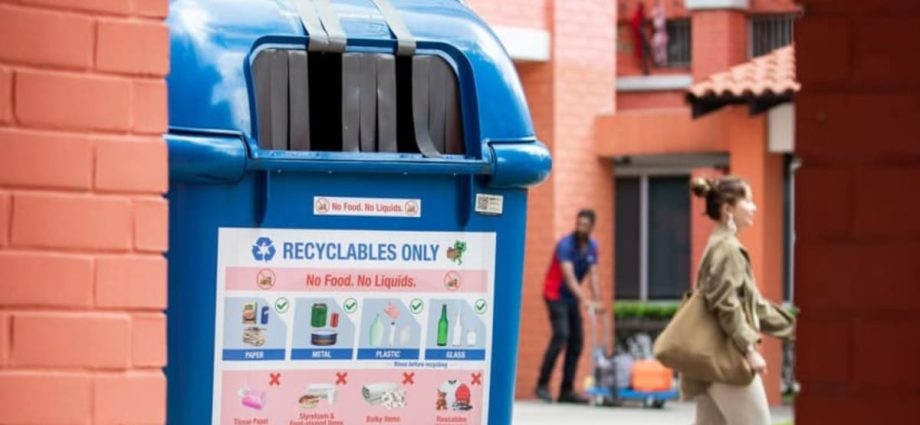
NEA had said that the facility, which is expected to be ready from 2027, will be able to recycle about 240,000 tonnes of waste from domestic sources such as households, shophouses and hawker centres annually.
However, experts cautioned that given the high land and labour costs in Singapore, there would be limits to how much it could expand its recycling capacity.
TODAY has asked NEA what is Singapore’s recycling capacity, and what is the capacity that can offset the amount of recyclable waste that cannot be exported.
HOW COVID-19 HAS CREATED MORE WASTE
The pandemic has also impacted recycling at a more downstream level, said experts.
Ms Jen Teo, executive director of the Singapore Environment Council, said that one reason for the drop in domestic recycling rate could be due to “revenge-shopping”, “revenge-dining-out” and “revenge-travelling” which has led to “a phenomenal rise” in rubbish production.
As people become more concerned about hygiene, the rise in single-use plastics, beverage and food containers also create more waste.
“The correct sorting and disposal of recyclable materials may become more difficult as a result of the increased waste creation,” said Ms Teo.
The rise in e-commerce during the pandemic also saw the emergence of sophisticated packaging and filling to ensure the safety of products as they were transported.
The mix of biodegradable and non-biodegradable materials in these packaging also led to complexities in recycling them, said Ms Teo.
The pandemic caused changes in recycling collection and processing, too.
For example, some recycling facilities had to reduce their services, such as collection frequencies, to comply with COVID-19 regulations. This could have resulted in delays to the recycling process and contributed to the decline in domestic recycling rates, said Ms Teo.
PERSISTENT PROBLEM OF CONTAMINATION
Another issue that plagues recycling in Singapore is the contamination of recyclable rubbish — 40 per cent of what goes into the blue bins cannot be recycled. The contamination rate has hovered at 40 per cent since 2018.
For domestic recycling, Singapore uses a single-stream recyclables collection system where every residential block is given a blue recycling bin for residents to use. All recyclable waste is then thrown into the bin and sorted centrally.
The authorities have justified this single-stream, or commingling approach, as one that helps to improve the recycling rate as it is more convenient for residents to recycle without having to sort their recyclables by material type.
Stickers are currently placed on the blue bins, indicating to residents what can and cannot be thrown inside. However, residents still throw in contaminating items, such as food and liquids, thus undermining the efforts of those who have recycled correctly.
“Recyclables that are contaminated by food or liquids cannot be recycled which makes them no different from general waste,” said Zero Waste SG. Despite being intended for recycling, this contaminated rubbish would be disposed of, incinerated and landfilled.
Contamination can also occur when a product is made up of mixed materials, and cannot be processed for recycling at a materials recovery facility.
Ms Robin Rheaume, the founder of Recyclopedia.sg, a ground-up initiative educating people on recycling, said that while plastic from industries may be easier to recycle because the material is homogenous and in large quantities, recyclable plastic from households is harder to sort, and therefore more prone to contamination.
She gave the example of how a whole bale of high-density polyethylene (HDPE) which is set aside for sale to recycling companies could be contaminated and reduced in its purity if it also contains polypropylene plastic which is a common post-consumer plastic.
HDPE plastic, which is made from petroleum, is commonly used for plastic or shampoo bottles while polypropylene plastic, which is a type of polymer, is commonly used in plastic packaging or machine parts.
This could deter some recycling companies from taking in recycling waste, as it is considered mixed waste, she said.
Ms Rheaume said material recovery facilities in Singapore may not have the technology required to sort and process recyclables to match the purity levels required by importers.
At the ground level, retiree Madam Jane Tan, 74, who lives in Ang Mo Kio, has often seen for herself how the recycling process has been contaminated, which she attributed to a lack of awareness on the residents’ part.
“I always notice in my recycling bin that people like to anyhow throw. It’s quite a sad sight!”
Mdm Tan is aware of the labels on the recycling bin that give clear instructions on what can and cannot be thrown inside, and how some bottles must be washed before being thrown.
Ms Eunice Fong, 38, a resident of Mountbatten, said that she frequently sees her recycling bin overflowing. “Maybe they can provide separate bins, like one for paper materials and one for metal cans,” she said.
Although Ms Fong’s suggestion might reduce contamination, it could also mean more work for residents who want to throw their rubbish in the blue bins.

